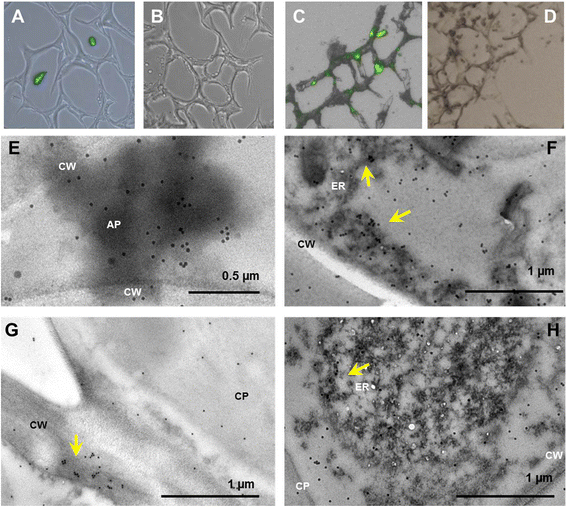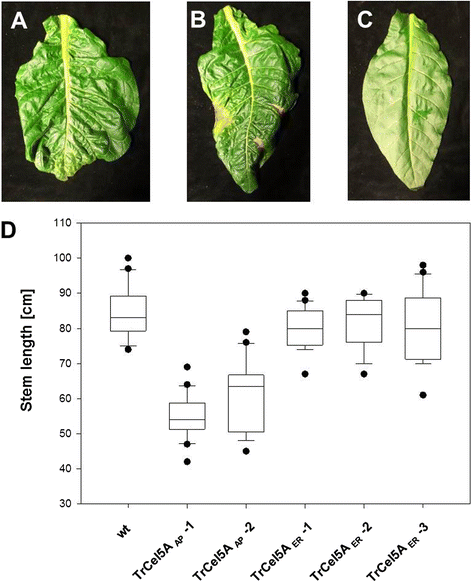Cell wall modification in tobacco by differential targeting of recombinant endoglucanase from Trichoderma reesei
- PMID: 25849300
- PMCID: PMC4340609
- DOI: 10.1186/s12870-015-0443-3
Cell wall modification in tobacco by differential targeting of recombinant endoglucanase from Trichoderma reesei
Abstract
Background: The development of transgenic plants as a production platform for biomass-degrading enzymes is a promising tool for an economically feasible allocation of enzymes processing lignocellulose. Previous research has already identified a major limitation of in planta production such as interference with the structure and integrity of the plant cell wall resulting in a negative influence on plant growth and development.
Results: Here, we describe the in planta expression of endoglucanase TrCel5A from the mesophilic fungus Trichoderma reesei with differential intracellular targeting and evaluate its impact on the tobacco cell wall composition. Targeting of the enzyme to the apoplast leads to distinct changes in cell polysaccharides such as glucose level in the matrix polysaccharides (MPS). These effects are combined with severe changes in plant development. Retention of TrCel5A in the endoplasmic reticulum (ER) could avoid visible effects on plant growth under the chosen conditions, but exhibits changes in the composition of the MPS.
Conclusions: These results give new insights into the complex interaction of heterologous cellulase expression with cell wall development and it outlines novel promising strategies to engineer plant cell walls for improved biomass processing.
Figures




Similar articles
-
Ethanol inducible expression of a mesophilic cellulase avoids adverse effects on plant development.Biotechnol Biofuels. 2013 Apr 16;6(1):53. doi: 10.1186/1754-6834-6-53. Biotechnol Biofuels. 2013. PMID: 23587418 Free PMC article.
-
Novel approach to produce biomass-derived oligosaccharides simultaneously by recombinant endoglucanase from Trichoderma reesei.Enzyme Microb Technol. 2020 Mar;134:109481. doi: 10.1016/j.enzmictec.2019.109481. Epub 2019 Nov 27. Enzyme Microb Technol. 2020. PMID: 32044028
-
Expression of a Trichoderma reesei β-1,4 endo-xylanase in tall fescue modifies cell wall structure and digestibility and elicits pathogen defence responses.Planta. 2012 Dec;236(6):1757-74. doi: 10.1007/s00425-012-1724-9. Epub 2012 Aug 10. Planta. 2012. PMID: 22878642
-
The significance of cellulolytic enzymes produced by Trichoderma in opportunistic lifestyle of this fungus.J Basic Microbiol. 2014 Jul;54 Suppl 1:S2-13. doi: 10.1002/jobm.201300821. Epub 2014 Feb 14. J Basic Microbiol. 2014. PMID: 24532413 Review.
-
Deciphering the molecular mechanisms behind cellulase production in Trichoderma reesei, the hyper-cellulolytic filamentous fungus.Biosci Biotechnol Biochem. 2016 Sep;80(9):1712-29. doi: 10.1080/09168451.2016.1171701. Epub 2016 Apr 14. Biosci Biotechnol Biochem. 2016. PMID: 27075508 Review.
Cited by
-
RNA-Seq and iTRAQ Reveal the Dwarfing Mechanism of Dwarf Polish Wheat (Triticum polonicum L.).Int J Biol Sci. 2016 Apr 8;12(6):653-66. doi: 10.7150/ijbs.14577. eCollection 2016. Int J Biol Sci. 2016. PMID: 27194943 Free PMC article.
-
Transgenic expression of fungal accessory hemicellulases in Arabidopsis thaliana triggers transcriptional patterns related to biotic stress and defense response.PLoS One. 2017 Mar 2;12(3):e0173094. doi: 10.1371/journal.pone.0173094. eCollection 2017. PLoS One. 2017. PMID: 28253318 Free PMC article.
-
The TcEG1 beetle (Tribolium castaneum) cellulase produced in transgenic switchgrass is active at alkaline pH and auto-hydrolyzes biomass for increased cellobiose release.Biotechnol Biofuels. 2017 Nov 30;10:230. doi: 10.1186/s13068-017-0918-6. eCollection 2017. Biotechnol Biofuels. 2017. PMID: 29213306 Free PMC article.
-
Transcriptome-wide sequencing provides insights into geocarpy in peanut (Arachis hypogaea L.).Plant Biotechnol J. 2016 May;14(5):1215-24. doi: 10.1111/pbi.12487. Epub 2015 Oct 26. Plant Biotechnol J. 2016. PMID: 26502832 Free PMC article.
-
Towards an Understanding of Enhanced Biomass Digestibility by In Planta Expression of a Family 5 Glycoside Hydrolase.Sci Rep. 2017 Jun 29;7(1):4389. doi: 10.1038/s41598-017-04502-1. Sci Rep. 2017. PMID: 28663545 Free PMC article.
References
-
- Harris PJ, Stone BA. Biomass Recalcitrance. Oxford: Blackwell Publishing Ltd; 2009. Chemistry and Molecular Organization of Plant Cell Walls; pp. 61–93.
-
- Himmel ME, Picataggio SK. Biomass Recalcitrance. Oxford: Blackwell Publishing Ltd; 2009. Our Challenge is to Acquire Deeper Understanding of Biomass Recalcitrance and Conversion; pp. 1–6.
Publication types
MeSH terms
Substances
LinkOut - more resources
Full Text Sources
Other Literature Sources

